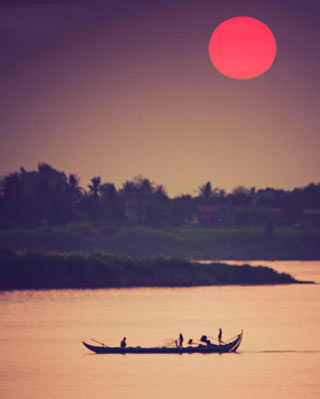What to Expect on a Lower Mekong River Cruise Through Vietnam and Cambodia
You’re planning to visit Vietnam and Cambodia, but unsure of the best way to explore? We would be more than happy to introduce you to the most authentic, unique, and luxurious way to enjoy - cruising from Vietnam to Cambodia or vice versa. A Mekong voyage between these two amazing countries is exciting but yet relaxed, and most of all, it presents the tale of the mother river that has nurtured ancient civilizations in an unfiltered way. Read our post to see highlights you can expect when cruising along the mighty Mekong through Vietnam Cambodia.

Embark on a daily changing adventure
Cruising along the lower Mekong is a unique experience that showcases the vast diversity of the region. The colorful, evergreen delta in southern Vietnam, with all of its sights and sounds, captivates tourists and invites close observation and in-depth discovery. Passing the border to Cambodia, the almighty Mekong flows softly around the capital, Phnom Penh, which has a captivating heritage and a long history contrasting with its modernity. Meanwhile, the uncharted Mekong River northeast of Phnom Penh and the Tonle River are integral parts of rural Cambodia's heartland and are teeming with intriguing hidden gems.

As nature and landscapes shift along the winding river, so do the people and old civilizations, creating a kaleidoscope of amazing experiences.
Explore the agricultural powerhouse of Vietnam – the Mekong Delta
Vietnam and Cambodia would be quite different without the vast Mekong Delta, which provides the majority of food for its inhabitants. The southern region of Vietnam contributes to one of the largest inland aquaculture sectors in the world, in addition to producing an abundance of fruits in the country, such as coconut, watermelon, jackfruit, durian, rambutan, and dragon fruit. This water-rich region is also outstanding for its ability to generate three rice harvests a year. Around half of the nation's food supply comes from the Mekong Delta (80% fruit, 60% fish, and 55% rice).

The plethora of agri- and aqua-cultural activities are on view every minute of the day, making it an enchanting area to observe and experience.
Learn about traditional craftsmanship
People living around the lower Mekong have been practicing traditional handcraft for centuries. The dried fibers of the water hyacinth, which is the fastest-growing free-floating plant in the world, are used by Mekong Delta villagers to weave mats, handbags, baskets, and other items. The ubiquitous coconut in the delta is also used to manufacture a variety of products, including candies, oil, and soap. Some workshops focus on producing specialities made from rice, such as rice paper, rice wine, and the ever-popular sweet, crunchy "pop rice".

On the Khmer side, skilled artisans sculpt images out of wood and stone, and the villagers have long manufactured the country’s renowned silk and high-end garments by hand since ancient times. Clay pottery is another handcraft from Cambodia, especially from Kampong Chhnang province, where materials and techniques have mainly stayed unchanged since the 5th century.

Savor delectable cuisine
Due to the abundance of coconut and sugar cane, southern Vietnamese cuisine is sweeter than its northern counterpart, while some spicy recipes have been influenced by Cambodia. When onboard Mekong River Cruises, you can still taste some signature dishes from the north, such as the famous rice noodle soup “Pho” and the local baguette sandwich “Banh Mi”. Fresh spring rolls wrapped in rice paper, or "Goi Cuon," is another mouthwatering southern delicacy that is best enjoyed with locally produced fish sauce in the delta.

Additionally, Cambodia offers some culinary delights, such as “Bai Sach Chrouk”, which is grilled pork marinated with fresh veggies and broken rice, and “Fish Amok”, which is steamed fish in curry and coconut milk.
Enjoy a voyage through culture and history
Exploring the history and culture of the lower Mekong is a thrilling venture. Buddhism has been around for more than two millennia, and it continues to have a significant impact on people's lives and morals even now. Hinduism is still deeply ingrained in Cambodian culture, and it is frequently reflected in crafts, artwork, and architecture (particularly from the Angkor period). On the other hand, Buddhism is frequently combined with Taoism, Confucianism, and the veneration of spirits and ancestors in Vietnam.

Throughout the past, Cambodian and Vietnamese cultures have been influenced by many eastern and western powers; however, despite their long and intricate histories, both countries have managed to hold onto their centuries-old origins.
Discover the three pearls of Indochina
The classic route along the Lower Mekong will take you through three of Indochina's jewel cities: Saigon, Phnom Penh, and Siem Reap. Each of these destinations has its own enthralling allure and unique charm, with a blend of colonial legacy, warm-hearted people, rich heritage, ancient tradition, and varied culture.

Saigon is a city full of modernity, energy, and local street flair mixed with colonial architecture. Phnom Penh enchants with its charming rusticity. The capital city is located at the confluence of the Mekong and Tonle Sap Rivers, where a promenade creates a European riverbank scene and several historic sites are easily accessible on foot. And lastly, Siem Reap, home to Angkor Wat, the biggest temple complex in the world, takes great pride in its intriguing lifestyle and local art.

It is vital to know what you should expect when traveling on luxury Mekong River Cruises. If the idea of embarking on a journey along the powerful Mekong River excites you, don’t hesitate to contact our travel experts to find the best cruises for your Southeast Asia holiday.
















